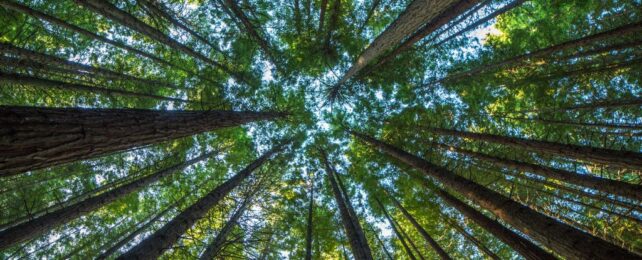An alarming report from the US Department of Agriculture predicts that by 2070, the nation's forests will release substantially more carbon than they store.
Forests in the US – bar those in Alaska – will no longer absorb 150 million metric tons of carbon a year within five decades, experts say.
That carbon is equivalent to the emissions of roughly 40 coal power plants.
To understand how a carbon sink can become a carbon tap, we have to consider the lifecycle of a healthy forest, where new growth matures into old growth and old growth dies and makes room for new growth.
But today, in North America, not enough young trees are being planted and allowed to grow up.
This means that mature forests are outpacing young forests, which are also more likely to be harvested or killed due to climate effects like wildfires, drought, or storms.
The overall shift to an older age cohort of trees means that in the future, forests in the US could be dying more than they are growing.
Practically, this turns forests from carbon absorbers to carbon emitters.
Old growth trees hold the most carbon in total, but after reaching a certain size, their growth seems to slow. Young trees, on the other hand, rapidly take up carbon for growth.
This could mean that if there are fewer younger trees in the future, there will be less carbon absorbed by America's forests each year.
Planting new forests could help solve the aging tree problem, but space is limited and hotly contested by industry interests.
In the past, some scientists have suggested removing old forests to make way for young forests, but as experts at the US Department of Agriculture (USDA) note, this approach is based on outdated science.
Old forests are slow-growing but some emerging evidence suggests they still continue to sequester carbon at rates that far outpace younger forests.
If we remove these previously undisturbed and intact ecosystems, we are most likely shooting ourselves in the foot.
The ecosystem services they provide for us are extensive, like global nutrient cycling, preventing erosion, increasing water and air quality, stabilizing local weather conditions and providing habitat for wildlife – including the pollinators our crops rely on.
Large trees may store even more carbon than we thought, and cutting them down, depending on how they're used, could potentially release all those emissions into the atmosphere once again.
The USDA report warns that "the ability of forests to provide the goods and services that society depends upon will be challenged over the next 50 years."
In April of this year, the US Forest Service announced a pathway to protecting old-growth trees from being cut down in federally managed forests.
At the moment, though, the government still allows these trees to be logged. And that's just the trees on public land. The majority of forests in the US are owned privately.
"There are an estimated 9.6 million family forest ownerships across the country and they control more forest land than any other ownership category (39 percent, excluding interior Alaska)," reads a section of the recent USDA report, "but most do not have a written forest management plan and have not received forest management advice."
What's even more discouraging is that federally managed forests are also managed in ways that threaten the future of these precious ecosystems. In June, the US Forest Service announced its plans to allow carbon waste from industry to be dumped in national forests.
"Turning our national forests into industrial dumping grounds is outrageous and completely wrongheaded," says Victoria Bogdan Tejeda, an attorney at the Center for Biological Diversity's Climate Law Institute.
"There's no place in our national forests for carbon capture scams that only benefit polluting industries. The administration should scrap this rule and enact one that protects mature and old-growth forests and trees."
If the US wants to reach its current goal of net-zero emissions by 2050, it must remove as much carbon from the atmosphere as it emits.
Doing so without its carbon-absorbing forests will be extremely difficult. Especially if they turn from a help to a hindrance.
The USDA report is available here.
